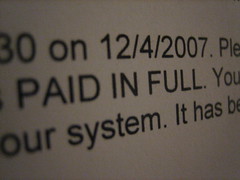 Many Americans have just earned their degrees with a June graduation, and that might mean confronting a cold, hard, and unpleasant reality: student loan debt. With tuitions rising and more and more people choosing a master’s degree in addition to a bachelor’s degree, this debt can quickly get out of hand. And when all those nice in-school deferments run their course, some students might experience some soul-crushing payments from multiple lenders that add up to $500 or more each month.
Many Americans have just earned their degrees with a June graduation, and that might mean confronting a cold, hard, and unpleasant reality: student loan debt. With tuitions rising and more and more people choosing a master’s degree in addition to a bachelor’s degree, this debt can quickly get out of hand. And when all those nice in-school deferments run their course, some students might experience some soul-crushing payments from multiple lenders that add up to $500 or more each month.
One solution to reduce the headaches—and the money flying out of your pockets—is a direct consolidation loan through the Department of Education. And there are a few reasons why this makes sense for a lot of people.
Consolidating your loans reduces three or four lenders down to one. For those of us who don’t want to spend every waking moment figuring out who has loaned what and which variable interest rates go with which lender, this is a beautiful simplification. The Department of Education will pay off all your existing lenders, stick a low, fixed interest rate on your consolidation loan, and then ask for just one payment a month instead of three or four.
But perhaps more importantly, ex-students experiencing some degree of financial hardship (which is not uncommon coming out of school, and particularly not uncommon in this economy) have access to repayment plans that factor in adjusted gross income (AGI) and family size in order to calculate a monthly payment that’s not so onerous. While amounts vary, a typical income-based repayment (or IBR) plan on a “biggie” total loan of $160,000, given a family size of one and an AGI of $26,000, would result in a fixed monthly payment of around $125. This is terrific relief for the same individual who might be paying $500 or $600 in a non-consolidated environment with private lenders. Naturally you’re paying more interest, but you avoid the crush of huge and often impossible payments. And that’s priceless.
There are a few catches any potential consolidator should bear in mind. The IBR plan requires regular submissions of tax forms and other supplementary financial information because the plan is based on your current income, so there is some bothersome paperwork involved. Private students loans are ineligible for federal consolidation: yes, those wonderful private loans are essentially credit card accounts without the credit cards. Lastly, and perhaps most importantly for the mightily-struggling ex-student: you’re not allowed to adopt the IBR plan if you’ve defaulted on your federal student loans. If you’re in a real financial funk and you haven’t paid your student loans in a few months, step on the gas and consolidate as quickly as possible before any defaults. Defaulting on federal loans isn’t like defaulting on credit card accounts: Uncle Sam has much bigger and sharper teeth. So IBR is truly your lifesaver in a sea of debt, and you should grab it while you can.
Have you begun tackling your student loans? Are yours already paid off? Share your thoughts and experiences below.



















